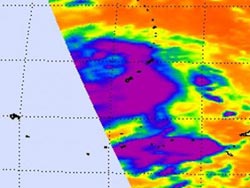NASA satellite sees Tropical Storm Sanvu pass Guam, strengthen

This infrared image of Tropical Storm Sanvu was captured from the AIRS instrument on NASA's Aqua satellite on May 22, and shows a large area of very strong thunderstorms near the center of circulation. The purple color indicates the coldest cloud top temperatures, and strongest thunderstorms with the heaviest rainfall.<br><br>Credit: Credit: NASA JPL, Ed Olsen<br>
On May 22 at 0900 UTC (5 a.m. EDT), Tropical Storm Sanvu was more than 100 miles west-northwest of Andersen Air Force Base, Guam, and still over 600 nautical miles south of Iwo To, Japan and headed in that direction.
Sanvu's center was located near 15.2 North and 141.9. East. It was still churning up rough surf around Guam. Sanvu has maximum sustained winds near 45 knots (52 mph/83 kph) with higher gusts. Sanvu is a compact tropical storm, with tropical-storm-force winds extending out 90 miles from the center, making it about 180 miles in diameter.
An infrared image of Tropical Storm Sanvu was captured from the Atmospheric Infrared Sounder (AIRS) instrument onboard NASA's Aqua satellite on May 22, and shows a large area of very strong thunderstorms near the center of circulation.
Forecasters at the Joint Typhoon Warning Center noted the AIRS imagery “shows the system has further consolidated and convection has resurged, especially along the northeast flank.”
Forecasters expect Sanvu to keep intensifying as it moves closer to Iwo To because of warm sea surface temperatures and light wind shear. Thereafter it is expected to curve to the northeast and transition to an extra-tropical storm.
Media Contact
More Information:
http://www.nasa.govAll latest news from the category: Earth Sciences
Earth Sciences (also referred to as Geosciences), which deals with basic issues surrounding our planet, plays a vital role in the area of energy and raw materials supply.
Earth Sciences comprises subjects such as geology, geography, geological informatics, paleontology, mineralogy, petrography, crystallography, geophysics, geodesy, glaciology, cartography, photogrammetry, meteorology and seismology, early-warning systems, earthquake research and polar research.
Newest articles

Trotting robots reveal emergence of animal gait transitions
A four-legged robot trained with machine learning by EPFL researchers has learned to avoid falls by spontaneously switching between walking, trotting, and pronking – a milestone for roboticists as well…

Innovation promises to prevent power pole-top fires
Engineers in Australia have found a new way to make power-pole insulators resistant to fire and electrical sparking, promising to prevent dangerous pole-top fires and reduce blackouts. Pole-top fires pose…

Possible alternative to antibiotics produced by bacteria
Antibacterial substance from staphylococci discovered with new mechanism of action against natural competitors. Many bacteria produce substances to gain an advantage over competitors in their highly competitive natural environment. Researchers…





















